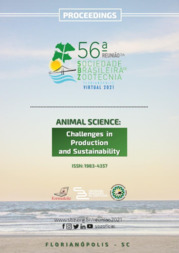The effect of the harvesting frequency on the residual forage mass in mixed pastures.
The effect of the harvesting frequency on the residual forage mass in mixed pastures.
Autoria: MATOS, B. F. de; ARAÚJO, G. P. de; BEHLING NETO, A.; WRUCK, F. J.; OLIVEIRA JUNIOR, O. L. de; PEDREIRA, B. C. e
Resumo: The use of different forage species in a mixed pasture is recommended to improve forage mass and soil characteristics. However, the frequency of harvest (e.g.; grazing or hay) can increase the forage removal during the off-season, and affect the residual forage mass to the following crop, especially in the non-till crop-livestock systems. We aimed to assess the harvest frequency effect in a mixed pasture compounded by Urochloa ruziziensis, pigeon pea (Cajanus cajan ?Super N?); Sunflower (Helianthus annuus), and Buckwheat (Fagopyrum esculentum) on the residual forage mass at the Embrapa Agrossilvipastoril, in Sinop, MT, Brazil. The mixed were planted on March 10, 2020, after the soybean harvest. The experimental design was a randomized complete block design with three replicates. The treatments were four harvest frequencies. The harvesting frequencies were: Straw ? no-harvest during the off-season; Lax - with one harvest (at 115 days after planting); Moderate - two harvests (80 and 115 days after planting); and Heavy - three harvests (45, 80, and 115 days after The plots were harvested at 20-cm stubble height and there were not fertilized. On September 30, 2020, forage mass was harvested using three quadrats (0.5 m2) per plot, at soil level, to calculate residual forage mass, which was desiccated (4 L ha-1 of glyphosate) on October 23, 2020. The soybean (BG4781, Brevant) was seeded on November 07, when 88 kg of P2O5 was applied. On December 01, 68 kg of K surface-applied. The crop management practices (e.g.; herbicide, insecticide, and fungicide) were similar to all plots, and on March 09, 2021, the soybean was harvested (data not showed). The residual forage mass was affected by the harvesting frequency (P=0.0296). The greatest residual forage mass was measured in the treatment where there was no harvesting (straw), on average 5625 kg DM ha-1. On the other hand, lax, moderate and heavy treatments presented similar residual forage mass (on average, 3000 kg DM ha-1). We concluded that although the residual forage mass was reduced when the off-season pastures were harvested, the number of harvest events did not affect the forage mass left on the field to assure the non-till cropping system. It is important to mention the soybean grain yield needs to be measured in the following crop season to understand the effect of the harvesting frequency during the off-season.
Ano de publicação: 2021
Tipo de publicação: Resumo em anais e proceedings
Unidade: Embrapa Agrossilvipastoril
Palavras-chave: Colheita, Cropping systems, Forragem, Fungicida, Helianthus, Herbicida, Inseticida, Livestock, Pastagem Mista, Urochloa ruziziensis
Observações
1 - Por padrão são exibidas publicações dos últimos 20 anos. Para encontrar publicações mais antigas, configure o filtro ano de publicação, colocando o ano a partir do qual você deseja encontrar publicações. O filtro está na coluna da esquerda na busca acima.
2 - Para ler algumas publicações da Embrapa (apenas as que estão em formato ePub), é necessário ter, no celular ou computador, um desses softwares gratuitos. Sistemas Android: Google Play Livros; IOS: iBooks; Windows e Linux: software Calibre.
Acesse outras publicações
Acesse a Base de Dados da Pesquisa Agropecuária (BDPA) para consultar o acervo completo das bibliotecas da Embrapa.

